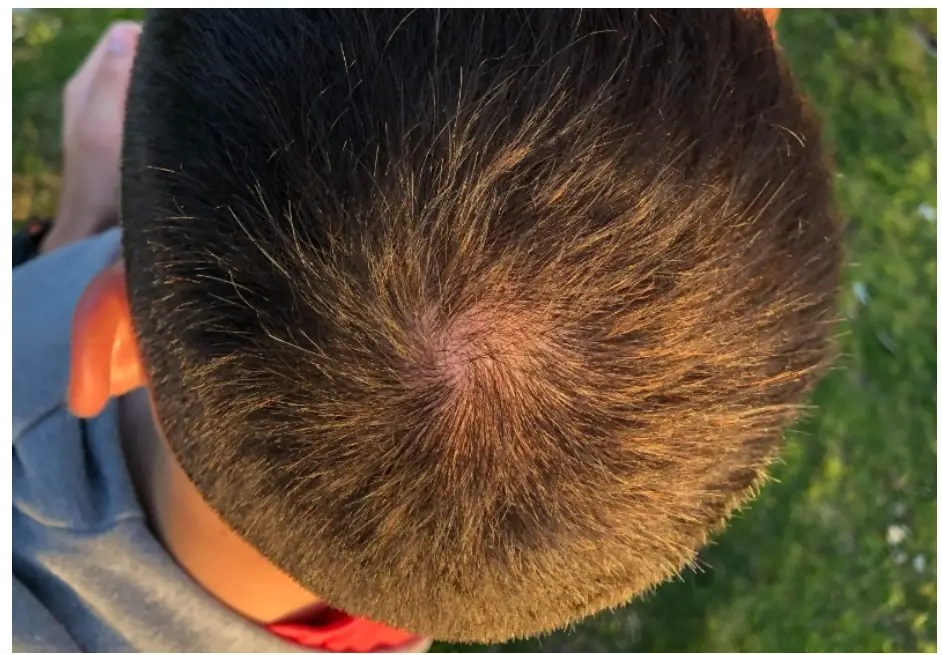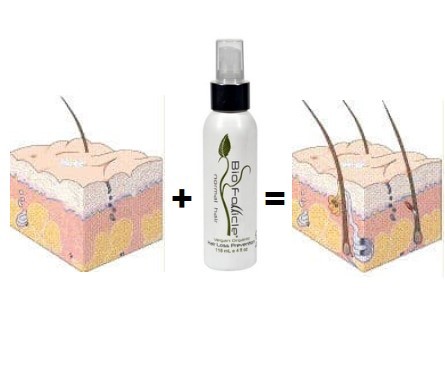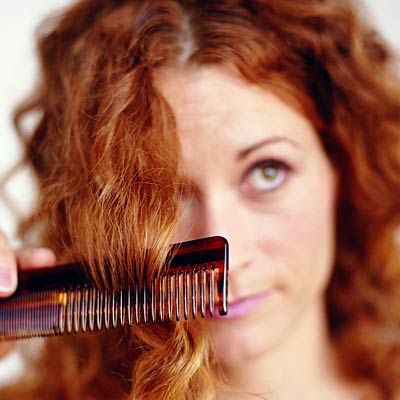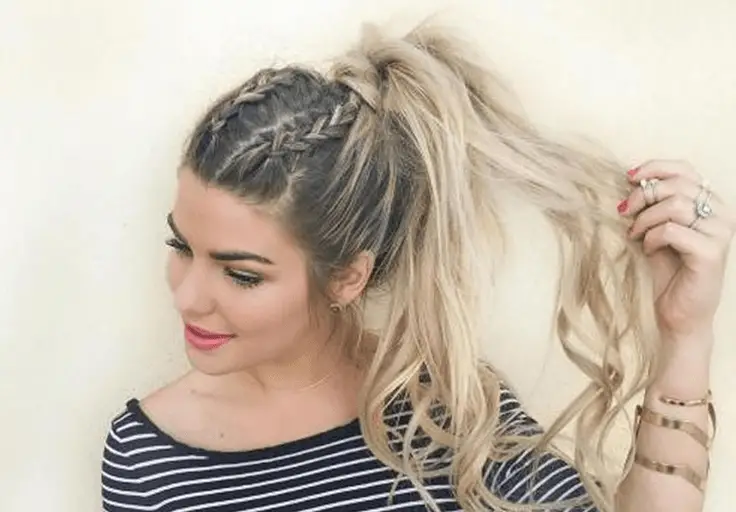Have you ever woken up, looked in the mirror, and asked yourself, “Why do I suddenly have a cowlick?” You’re not alone. Many people find themselves dealing with these pesky hair swirls that seem to have a mind of their own. Whether you’ve always had them or they’ve suddenly appeared, understanding cowlicks can help you manage them better.
In this comprehensive guide, we’ll delve into the world of cowlicks, exploring their causes, how they differ from balding, and how to style and manage them. We’ll also debunk some common myths associated with cowlicks and hair loss. So, whether you’re dealing with a bald cowlick, wondering about cowlicks vs. balding, or simply curious about this common hair phenomenon, this article is for you.
Before we dive in, it’s worth noting that cowlicks are completely normal. They’re simply a part of how your hair grows. However, if you’re noticing hair thinning around cowlick or are concerned about cowlick or balding, it’s important to understand the difference.
Ready to unravel the mystery of cowlicks? Let’s get started. And remember, if you’re dealing with hair concerns, our guide on hair loss myths is a great resource to separate fact from fiction.
Takeaways:
- Cowlicks are natural: Cowlicks are a natural part of your hair’s growth pattern. They’re caused by hair growing in a different direction and are often present from birth.
- Cowlicks are not a sign of balding: While cowlicks can sometimes be confused with balding, they’re not a sign of hair loss. However, if you’re noticing changes in your cowlick or if you’re concerned about hair loss, it’s important to seek professional advice.
- Managing cowlicks: Managing a cowlick involves understanding it, choosing the right haircut, using the right products, and blow-drying in the right direction. Sometimes, the best way to deal with a cowlick is to embrace it.
- Cowlicks and age: Cowlicks don’t necessarily get worse with age. However, as we age, our hair naturally becomes thinner and less voluminous, which can make existing cowlicks appear more prominent.
So, Why Do I Suddenly Have a Cowlick?
If you suddenly notice a cowlick, it could be due to a few reasons:
- Change in Hair Length or Style: If you’ve recently changed your hairstyle or allowed your hair to grow longer, a previously unnoticed cowlick might become more visible.
- Hair Loss or Thinning: If you’re experiencing hair loss or thinning, a cowlick can appear more prominent because there’s less hair to cover it.
- Hair Damage or Stress: Sometimes, damage to the hair from heat styling tools or chemical treatments can alter the direction of hair growth, leading to the appearance of a cowlick. Similarly, physical or emotional stress can sometimes affect hair growth patterns.
- Post-surgery or Injury: If you’ve had surgery or an injury to your scalp, the hair growing back in that area might form a cowlick.
If you’re concerned about a sudden cowlick, it might be worth consulting with a hair specialist or dermatologist. They can help determine if there’s an underlying issue that needs to be addressed.
But stay tuned as we explore the intriguing world of cowlicks and balding. Discover how to tell the difference, manage your hair, and embrace your unique hair growth patterns.
What is a Cowlick?
A cowlick is a section of hair that stands straight up or lies at an angle at odds with the style in which the rest of an individual’s hair is worn. Cowlicks appear when the growth direction of the hair forms in (against) the spiral pattern. The term “cowlick” originates from the domestic bovine’s habit of licking its young, which results in a swirling pattern in the hair. The most common site of a cowlick is in the crown, but they can show up anywhere.
In essence, a cowlick is like that one rebellious strand of hair that refuses to follow the crowd, choosing instead to dance to its own beat. It’s the hair equivalent of a non-conformist, choosing to grow in a different direction from the rest of your hair.
Cowlicks are incredibly common and can occur in both men and women. They’re often present at birth, which means you’ve probably had your cowlicks for as long as you’ve had hair. However, they can also form later in life due to various factors, such as the way you style your hair or even certain haircuts.
While cowlicks are usually harmless, they can sometimes be a nuisance, especially when it comes to styling your hair. They can disrupt what would otherwise be a sleek, smooth hairstyle, causing frustration for those who prefer a more polished look. But don’t worry, we’ve got you covered with some great tips on how to manage and style a cowlick later in this article.
Now, you might be wondering, “What does a cowlick look like?” or “Is my cowlick normal?” A cowlick typically looks like a swirl or spiral of hair growing in a different direction from the rest. It can be as small as a single strand of hair, or it can involve a larger section of hair. And yes, your cowlick is normal. In fact, most people have at least one cowlick.
If you’re still unsure about your cowlick or if you’re worried that it might be a sign of something more serious like balding, don’t fret. In our next section, we’ll discuss how to differentiate between a cowlick and balding.
For more insights on hair growth patterns and how they affect your hair’s appearance, check out our article on uneven hairlines.
Stay tuned as we delve deeper into the world of cowlicks and balding. Learn how to tell the difference and discover practical tips to manage and style your cowlick.
Cowlicks vs. Balding: Understanding the Difference
When it comes to hair, it’s easy to confuse a cowlick with the early signs of balding. After all, both can result in areas of hair that look different from the rest. However, cowlicks and balding are two very different things. Understanding the difference between cowlicks and balding is crucial, especially if you’re concerned about potential hair loss.
Cowlicks, as we’ve discussed, are natural hair growth patterns that cause some strands to grow in a different direction. They can make your hair stick up or swirl in a particular area, but they don’t lead to hair loss or thinning. Cowlicks are simply a part of your hair’s unique growth pattern.
Balding, on the other hand, involves a reduction in hair density and is often a result of aging, hormonal changes, or genetics. It’s characterized by progressively thinner hair, a receding hairline, or bald spots. Unlike cowlicks, balding can lead to complete hair loss in certain areas.
Here’s a simple comparison to help you understand the difference:
| Cowlicks | Balding |
|---|---|
| Natural hair growth pattern | Often a result of aging, hormonal changes, or genetics |
| Hair grows in a different direction | Hair becomes progressively thinner |
| Does not lead to hair loss or thinning | Can lead to complete hair loss in certain areas |
If you’re noticing that your hair is thinning around your cowlick or if your cowlick appears to be getting larger, it might be worth consulting with a hair specialist. They can help determine if you’re experiencing balding or just dealing with a cowlick.
Remember, it’s completely normal to have one or more cowlicks. However, if you’re noticing other signs of hair loss such as a receding hairline, thinning hair, or bald spots, it’s important to seek professional advice.
For more insights on hair loss and balding, check out our comprehensive guide on Cowlick or Balding: How to Tell the Difference.
Stay tuned as we delve deeper into the world of cowlicks and balding. Learn about the causes of cowlicks and discover practical tips to manage and style your cowlick. Remember, understanding your hair is the first step towards better hair care.
Read more:
- Hair Whorl or Balding: What’s the Difference?
- I Can See My Scalp Through My Hair – Am I Going Bald?
Causes of Cowlicks
Understanding the causes of cowlicks can help you better manage them and even learn to love them. After all, they’re part of what makes your hair uniquely yours. So, what causes these quirky hair patterns?
Genetics play a significant role in the formation of cowlicks. If your parents or siblings have cowlicks, there’s a good chance you might have them too. Cowlicks are often present at birth, which means they’re a part of your genetic makeup.
In addition to genetics, external factors can also contribute to the formation of cowlicks. For instance, the way you style your hair or the type of haircut you get can lead to the formation of a cowlick. If you’ve ever shaved your head, you might have noticed a cowlick or two when your hair started growing back. This is because shaving can disrupt your hair’s natural growth pattern, causing some strands to grow in a different direction.
Injuries or surgery to the scalp can also lead to the formation of cowlicks. When the hair grows back after an injury or surgical procedure, it might grow in a different direction, resulting in a cowlick.
Here’s a quick overview of the common causes of cowlicks:
- Genetics: If cowlicks run in your family, you’re likely to have them too.
- Hair styling and haircuts: Certain hairstyles or haircuts can disrupt your hair’s natural growth pattern, leading to cowlicks.
- Shaving: Shaving your head can cause your hair to grow back in a different direction, forming a cowlick.
- Injuries or surgery: Any disruption to your scalp, such as an injury or surgery, can affect your hair’s growth pattern and cause a cowlick.
Remember, cowlicks are completely normal and most people have at least one. However, if you’re noticing changes in your cowlick or if you’re concerned about hair loss, it’s important to seek professional advice.
For more insights on hair growth patterns and how they affect your hair’s appearance, check out our article on Hair Thinning at the Crown: Causes and Solutions.
Stay tuned as we delve deeper into the world of cowlicks and balding. Learn about the impact of age on cowlicks and discover practical tips to manage and style your cowlick. Remember, understanding your hair is the first step towards better hair care.
Cowlicks and Age: Do Cowlicks Get Worse with Age?
As we age, many things about our bodies change, and our hair is no exception. You might be wondering, “Do cowlicks get worse with age?” The answer is not straightforward, as it depends on various factors, including your overall hair health and genetics.
Cowlicks themselves don’t necessarily get worse with age. They’re a part of your hair’s natural growth pattern and will remain the same unless something disrupts that pattern. However, as we age, our hair naturally becomes thinner and less voluminous, which can make existing cowlicks appear more prominent or noticeable.
Moreover, if you’re experiencing hair loss or thinning due to age, a cowlick can appear larger simply because there’s less hair to cover it. This is why some people might feel like their cowlicks are getting worse as they get older.
Here are some tips for managing cowlicks as you age:
- Maintain good hair health: Regular trims, a balanced diet, and proper hair care can help maintain your hair’s health and make cowlicks less noticeable.
- Choose the right hairstyle: Some hairstyles can help camouflage cowlicks. Talk to your hairstylist about the best options for your hair type and cowlick location.
- Use the right products: Certain hair products can help manage cowlicks and make them less noticeable. Look for products that provide hold and control.
Remember, cowlicks are a natural part of your hair’s growth pattern. While they can be a nuisance at times, they’re nothing to worry about. However, if you’re noticing significant hair thinning or loss, it’s important to consult with a professional.
How to Manage and Style a Cowlick
Managing and styling a cowlick can sometimes feel like a battle. But with the right techniques and products, you can learn to work with your cowlick, rather than against it. Here are some tips to help you manage and style your cowlick:
1. Understand Your Cowlick: The first step to managing a cowlick is understanding it. Pay attention to where it’s located and how your hair grows in that area. This will help you determine the best way to style it.
2. Choose the Right Haircut: Certain haircuts can help camouflage a cowlick. For instance, longer hair can weigh down a cowlick and make it less noticeable. Talk to your hairstylist about the best options for your hair type and cowlick location.
3. Use the Right Products: Hair products can be a game-changer when it comes to managing a cowlick. Look for products that provide hold and control, such as gels, pomades, or styling creams.
4. Blow Dry in the Right Direction: When drying your hair, aim the blow dryer in the direction you want your hair to lay. This can help train your cowlick to lay flat.
5. Embrace It: Sometimes, the best way to deal with a cowlick is to embrace it. After all, cowlicks can add character and uniqueness to your look.
Remember, everyone’s hair is different, so what works for one person might not work for another. It might take some trial and error to find the best way to manage and style your cowlick. But with patience and the right approach, you can learn to love your cowlick.
Frequently Asked Questions About Cowlicks
Cowlicks can be a source of many questions, especially if you’re dealing with one for the first time. Here, we’ve compiled some of the most frequently asked questions about cowlicks to help you understand them better.
Q: Can you make a cowlick go away?
A: Cowlicks are a natural part of your hair’s growth pattern, so they can’t be eliminated completely. However, certain hairstyles and products can help manage them and make them less noticeable.
Q: Can cowlicks change over time?
A: Cowlicks themselves don’t change over time, but they can appear more prominent if your hair is thinning or if you’re experiencing hair loss.
Q: Can a cowlick be a sign of balding?
A: A cowlick is not a sign of balding. However, if you’re noticing that your hair is thinning around your cowlick or if your cowlick appears to be getting larger, it might be worth consulting with a hair specialist.
Q: Can you develop a cowlick later in life?
A: While most cowlicks are present from birth, it’s possible to develop a cowlick later in life due to certain factors such as the way you style your hair or certain haircuts.
Q: How can I style my hair to hide a cowlick?
A: The best way to style your hair to hide a cowlick depends on your hair type and the location of your cowlick. Some people find that longer hairstyles help weigh down the cowlick, while others prefer shorter cuts that blend the cowlick in with the rest of their hair. Hair products that provide hold and control can also be helpful.
Remember, cowlicks are a normal part of your hair’s growth pattern. While they can be a nuisance at times, they’re nothing to worry about. However, if you’re noticing significant hair thinning or loss, it’s important to consult with a professional.
For more information on hair care and styling, check out our article on Do You Put Conditioner on Scalp?.
Conclusion
Cowlicks, those quirky swirls of hair that seem to have a mind of their own, are a natural part of your hair’s growth pattern. While they can sometimes be a nuisance, especially when it comes to styling your hair, they’re nothing to worry about.
Remember, cowlicks are not a sign of balding. However, if you’re noticing changes in your cowlick or if you’re concerned about hair loss, it’s important to seek professional advice.
At the end of the day, the key to managing cowlicks is understanding them and learning how to work with them. With the right approach, you can even learn to love your cowlicks and see them as a unique part of your look.
We hope this guide has helped you understand cowlicks better and has provided you with practical tips to manage and style them. Remember, understanding your hair is the first step towards better hair care.
For more insights on hair care and styling, don’t forget to check out our other articles, like this one on Beard Cowlicks: Causes and Solutions.
Source Urls
https://www.ncbi.nlm.nih.gov/books/NBK278957/
- AI Powered Bald Filter Online 2024: See Yourself with No Hair! - January 19, 2024
- Harklinikken Bad Reviews 2024: Analyzing Negative Feedbacks - January 18, 2024
- How to Get the Alex Eubank Hair | Step-By-Step Tutorial 2024 - January 18, 2024







